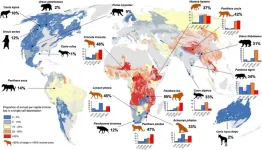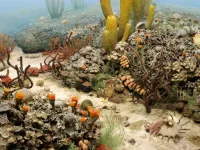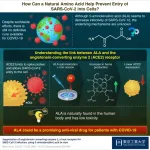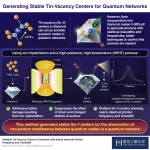(Press-News.org) Gestational diabetes and preeclampsia may be linked to slower biological development in infants, according to a new study led by USC.
The research, published today in JAMA Network Open, found that newborns exposed to these two pregnancy complications were biologically younger than their chronologic gestational age. The infants’ biological or “epigenetic” age is based on molecular markers in their cells.
The results raise intriguing questions about how common pregnancy complications may affect infants and health outcomes later in childhood. Could they create developmental delays? Could some exposures advance biological age prematurely, even in the womb? What about stressors such as exposures to environmental pollution?
“In aging research, if your epigenetic ‘clock’ shows an older age than your chronological age — due to exposures to various stressors — that’s viewed as bad, as putting people at increased risks for illness,” said corresponding author Carrie Breton, a professor of population and public health sciences at the Keck School of Medicine of USC. “We wondered how far back we could take this concept; could we take it to the womb?
“In this case we found the opposite — pregnancy complications led to babies with a younger biological age. This raises a ton of questions about the impact later in life. This is a fairly new metric and very little is known about it.”
For the study, researchers collected DNA samples from 1,801 newborns from 12 cohorts across the U.S. The participants were born between 1998 and 2008 to mothers who had preeclampsia, gestational diabetes or hypertension during pregnancies and compared to pregnancies without any of these complications.
The researchers used these samples to evaluate each infant’s epigenetic age. They then compared the epigenetic age to the infant’s chronological age at birth, measured in pregnancy weeks.
The researchers found that babies who were exposed to preeclampsia or gestational diabetes while they were developing in the womb were biologically younger than babies without the exposures, indicating that these exposures may have slowed down the babies’ biological development. The difference was more noticeable in female babies compared to male babies. Exposure to hypertension didn’t have a measurable impact.
“In the future, we plan to continue our research with a larger sample of participants and investigate whether these biological changes detected at birth are linked to health outcomes later in childhood,” said Breton. “If so, doctors and researchers could use that knowledge to develop targeted interventions that can reduce the adverse effects of preeclampsia and gestational diabetes on children’s health.”
In addition to Breton, other authors of the study are Elizabeth Vang, Sahra Mohazzab-Hosseinian, Zhongzheng Niu and Daniel Weisenberger of the Keck School; Christine Ladd-Acosta, Xingyu Gao, Meredith Palmore, Ashley Song and Heather Volk of Johns Hopkins University; Emily Barrett of Rutgers University; Catherine Bulka, Rebecca Fry and Michael O’Shea of the University of North Carolina at Chapel Hill; Nicole Bush of the University of California, San Francisco; Andres Cardenas of the University of California, Berkeley; Dana Dabelea of the University of Colorado; Anne Dunlop, Anna Knight, Elizabeth Kennedy and Alicia Smith of Emory University; Jaclyn Goodrich of the University of Michigan; Julie Herbstman of Columbia University; Marie-France Hivert of Harvard University; Linda Kahn and Leonardo Trasande of New York University; Margaret Karagas of Dartmouth College; Andréanne Morin of the University of Chicago; Douglas Ruden of Wayne State University; Rebecca Schmidt of the University of California, Davis; and Eliot Spindel of Oregon Health & Science University.
The research was supported by the Environmental influences on Child Health Outcomes Program (ECHO) at the National Institutes of Health.
# # #
END
Common pregnancy complications may slow development of infant in the womb, study finds
Newborns explosed to preeclampsia, gestational diabetes were biologically younger than their chronologic gestational age
2023-02-24
ELSE PRESS RELEASES FROM THIS DATE:
Developing countries pay the highest price for living with large carnivores
2023-02-24
A team of researchers has highlighted human-wildlife conflict as one of the globe’s most pressing human development and conservation dilemmas.
New research published in Communications Biology looked at 133 countries where 18 large carnivores ranged, and found that a person farming with cattle in developing countries such as Kenya, Uganda or India were up to eight times more economically vulnerable than those living in developed economies such as Sweden, Norway or the U.S.
Duan Biggs from Northern Arizona University’s School of Earth and Sustainability is the senior author of the study. He partnered with organizations throughout the world to conduct ...
Head injuries could be a risk factor for developing brain cancer
2023-02-24
Researchers from the UCL Cancer Institute have provided important molecular understanding of how injury may contribute to the development of a relatively rare but often aggressive form of brain tumour called a glioma.
Previous studies have suggested a possible link between head injury and increased rates of brain tumours, but the evidence is inconclusive. The UCL team have now identified a possible mechanism to explain this link, implicating genetic mutations acting in concert with brain tissue inflammation to change the behaviour of cells, making them more likely to become cancerous. Although this study was largely carried out in mice, it suggests ...
New study reveals biodiversity loss drove ecological collapse after the “Great Dying”
2023-02-24
SAN FRANCISCO, CA (February 24, 2023) — The history of life on Earth has been punctuated by several mass extinctions, the greatest of these being the Permian-Triassic extinction event, also known as the “Great Dying”, which occurred 252 million years ago. While scientists generally agree on its causes, exactly how this mass extinction unfolded—and the ecological collapse that followed—remains a mystery. In a study published today in Current Biology, researchers analyzed marine ecosystems before, during, and after the Great Dying ...
Differences in animal biology can affect cancer drug development
2023-02-24
A small but significant metabolic difference between human and mouse lung tumor cells, has been discovered by Weill Cornell Medicine researchers, explaining a discrepancy in previous study results, and pointing toward new strategies for developing cancer treatments.
The work, published Jan. 30 in Cancer Discovery, focuses on lung adenocarcinoma, a common but often difficult to treat cancer that researchers have long studied in mouse models. However, those models didn’t quite align with human clinical observations in some instances. The new paper shows why; a specific gene mutation has opposite effects on tumor ...
Manchester research captures and separates important toxic air pollutant
2023-02-24
Led by scientists at The University of Manchester, a series of new stable, porous materials that capture and separate benzene have been developed. Benzene is a volatile organic compound (VOC) and is an important feedstock for the production of many fine chemicals, including cyclohexane. But, it also poses a serious health threat to humans when it escapes into the air and is thus regarded as an important air pollutant.
The research published today in journal Chem, demonstrates the high adsorption of benzene at low pressures and concentrations, as well as the efficient separation of benzene and cyclohexane. This was achieved by the design and successful preparation ...
Using the power of artificial intelligence, new open-source tool simplifies animal behavior analysis
2023-02-24
Graphic
A team from the University of Michigan has developed a new software tool to help researchers across the life sciences more efficiently analyze animal behaviors.
The open-source software, LabGym, capitalizes on artificial intelligence to identify, categorize and count defined behaviors across various animal model systems.
Scientists need to measure animal behaviors for a variety of reasons, from understanding all the ways a particular drug may affect an organism to mapping how circuits in the brain communicate to produce a particular behavior.
Researchers ...
WHO and ESCEO announce collaborative agreement to benefit global osteoporosis and fracture prevention
2023-02-24
The World Health Organization (WHO) and the European Society for Clinical and Economic Aspects of Osteoporosis, Osteoarthritis and Musculoskeletal Diseases (ESCEO) signed an agreement to develop a strategic roadmap on bone health and ageing and advocate for a public health strategy to prevent fractures among older people. The collaboration entails a strategic roadmap of research and publication deliverables, in recognition of the fact that osteoporosis is a major contributor to the Global Burden of Disease.
The collaboration agreement, signed on February 23, 2023, at WHO Headquarters in Geneva, Switzerland, is an important ...
Discovery suggests new way to prevent common causes of vision loss
2023-02-24
UVA Health scientists have discovered an unknown contributor to harmful blood vessel growth in the eye that could lead to new treatments for blinding macular degeneration and other common causes of vision loss.
UVA’s Jayakrishna Ambati, MD, and Shao-bin Wang, PhD, and their colleagues have identified a new target to prevent the formation of abnormal tangles of blood vessels associated with eye conditions such as neovascular age-related macular degeneration, proliferative diabetic retinopathy and ischemic retinal vein occlusion.
“Our study has opened up the possibility of mitigating ...
Could a naturally occurring amino acid lead us to a cure for COVID-19?
2023-02-24
After more than two years since its discovery, six million deaths, and half a billion reported cases, there is still no effective cure for COVID-19. Even though vaccines have lowered the impact of outbreaks, patients that contract the disease can only receive supportive care while they wait for their own body to clear the infection.
A promising COVID-19 treatment strategy that has been gaining traction lately is targeting angiotensin-converting enzyme 2 (ACE2). This is a receptor found on the cell membrane that allows entry of the virus into the cell due to its ...
Breakthrough in tin-vacancy centers for quantum network applications
2023-02-24
Quantum entanglement refers to a phenomenon in quantum mechanics in which two or more particles become linked such that the state of each particle cannot be described independently of the others, even when they are separated by a large distance. The principle, referred to by Albert Einstein as "spooky action at a distance", is now utilized in quantum networks to transfer information. The building blocks of these networks—quantum nodes—can generate and measure quantum states.
Among the candidates that can function as ...
LAST 30 PRESS RELEASES:
Making lighter work of calculating fluid and heat flow
Normalizing blood sugar can halve heart attack risk
Lowering blood sugar cuts heart attack risk in people with prediabetes
Study links genetic variants to risk of blinding eye disease in premature infants
Non-opioid ‘pain sponge’ therapy halts cartilage degeneration and relieves chronic pain
AI can pick up cultural values by mimicking how kids learn
China’s ecological redlines offer fast track to 30 x 30 global conservation goal
Invisible indoor threats: emerging household contaminants and their growing risks to human health
Adding antibody treatment to chemo boosts outcomes for children with rare cancer
Germline pathogenic variants among women without a history of breast cancer
Tanning beds triple melanoma risk, potentially causing broad DNA damage
Unique bond identified as key to viral infection speed
Indoor tanning makes youthful skin much older on a genetic level
Mouse model sheds new light on the causes and potential solutions to human GI problems linked to muscular dystrophy
The Journal of Nuclear Medicine ahead-of-print tip sheet: December 12, 2025
Smarter tools for peering into the microscopic world
Applications open for funding to conduct research in the Kinsey Institute archives
Global measure underestimates the severity of food insecurity
Child survivors of critical illness are missing out on timely follow up care
Risk-based vs annual breast cancer screening / the WISDOM randomized clinical trial
University of Toronto launches Electric Vehicle Innovation Ontario to accelerate advanced EV technologies and build Canada’s innovation advantage
Early relapse predicts poor outcomes in aggressive blood cancer
American College of Lifestyle Medicine applauds two CMS models aligned with lifestyle medicine practice and reimbursement
Clinical trial finds cannabis use not a barrier to quitting nicotine vaping
Supplemental nutrition assistance program policies and food insecurity
Switching immune cells to “night mode” could limit damage after a heart attack, study suggests
URI-based Global RIghts Project report spotlights continued troubling trends in worldwide inhumane treatment
Neutrophils are less aggressive at night, explaining why nighttime heart attacks cause less damage than daytime events
Menopausal hormone therapy may not pose breast cancer risk for women with BRCA mutations
Mobile health tool may improve quality of life for adolescent and young adult breast cancer survivors
[Press-News.org] Common pregnancy complications may slow development of infant in the womb, study findsNewborns explosed to preeclampsia, gestational diabetes were biologically younger than their chronologic gestational age




